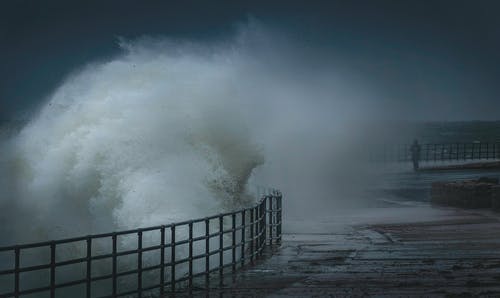North Carolina is prone to hurricanes, which can cause significant damage to houses and landscaped areas like commercial gardens.
Because re-planting is costly and time-consuming, building managers and owners might have to work with commercial landscaping experts. They can use their expertise to design a garden that can better withstand the onslaught and is easy to maintain or rebuild.
But clients can also participate in the process. They can take steps to reduce storm damage to landscaped plants using these questions:
Do You Have Potential Storm Surge or Flooding?
Water flooding onto the property from storm surge or rising rivers can transport sand, soil, pollutants, even lawn chemicals into ponds and lakes where it is difficult to remove them.
This water flow can also push sediment into the waterways where it settles, reducing light penetration and slowing photosynthesis. It can lead to reduced plant growth. Sediment-laden water flowing into waterways also reduces oxygen levels in the system, causing fish kills.
This problem becomes worse because sandy soils promote faster water runoff and are also often high in nutrients, especially nitrogen.
As rainwater moves through these sands, nutrients are released into the waterways much more rapidly than if they were drained through a different type of soil with lower nutrient content. Storm surge waters typically contain even higher fertilizers and other pollutants from lawns, landscaping, or croplands upstream.
To protect the plants from the effects of water surges and flooding, the landscape can incorporate berms or raised beds. Landscapers can also identify the condition of the soil after heavy rain. Those that remain wet can benefit from plants that can tolerate high levels of moisture. These can include the elephant’s ear, iris, water hyssop, and cattail.
Do Your Trees Have Proper Branch Support?
In tropical climates, many trees have aerial prop roots that emerge from their trunk and branches to help support their foliage. In Florida, this is a wonderful adaptation if a tree needs to grow upright but does little for a tree’s stability when lateral winds whip through it during a hurricane.
If the commercial property has these trees, they need support using guy wires attached to the ground or properly installed steel stakes. The property owners or managers might also consider pruning back any low-hanging limbs that will not be supported by the wire or stakes and those that could create an obstacle for people walking around the property after a storm.
Does the Landscape Include Weak Trunk Wood that Can Split during a Storm?
If the landscape includes trees with thin or weak wood prone to splitting, landscapers might remove them. The same goes for trees with branches near the top of the canopy. In some cases, these trees have to be removed. But this process should be completed even before a hurricane strikes to ensure proper disposal.
Does the Landscape Have Vulnerable Shrubs?
Many commercial property owners fail to realize their landscape shrubbery can generate significant damage during strong storms. One example might be the Japanese hibiscus. It can typically break apart at their base when winds enter their crowns because they have a very poor root system.
Those with these types of plants near their building can consider trimming back some of their branches before a hurricane strikes. Doing so can help reduce the amount of damage they will cause or minimize the problem for the property’s foundation and roof.
Do You Want to Keep Your Lawn?
If you want to keep your lawn during a storm, you must maintain it regularly with the appropriate number of fertilizer applications.
Using more than recommended by landscapers or less than necessary can result in turfgrass damage when high winds enter the foliage canopy during hurricanes. This occurs because grass blades are typically not stiff enough to withstand high wind speeds. These cause them to bend over and die.
If you want to keep your lawn healthy during hurricanes, consider watering it at least once a week to stimulate new growth after the storm.
Over the years, more people realize the value of a landscaped garden. Not only does it boost curbside appeal, but it can also improve a person’s physical and mental well-being. For businesses, this can translate to higher productivity due to better focus, less stress, and hopefully lower rates of absenteeism.
Therefore, protecting the commercial landscape before and after a hurricane is also about ensuring that you can preserve these benefits.







